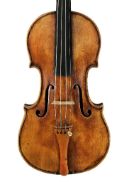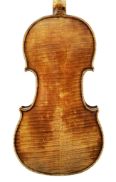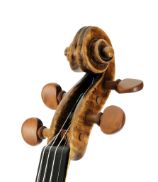Violin, Nicola Bergonzi, Cremona, 1780–1790, “ex Hamma-Segelman”
This instrument has no label, but may be classified as Nicola Bergonzi’s work by virtue of its stylistic features, notably its contours with their straight, somewhat stiff-looking C-bouts. The cut of the f-holes, which sit very upright in the belly, is also quite typical of Nicola Bergonzi’s style. The instrument was built on a small model and displays moderately high arching, with the belly arched more than the back. The two-piece belly has moderately wide annual rings. According to a dendrochronological report, the most recent annual ring was from 1756. The divided, quarter-cut back exhibits intense flames rising from the treble to the bass side. Wings were added in both flanks of the lower bouts. The ribs, pegbox and scroll are made of highly flamed maple. The arching ends in pronounced fluting, which comes together in a V shape in the corners that is reminiscent of Guarneri del Gesù’s violins. The violin has a broad purfling that is consistent with the wide and massive edge. Its f-holes with their perfectly circular eyes are positioned straight, letting the chest of the instrument appear quite wide. Nicola carved the volutes with very long eyes, as did his forebears Carlo and Michelangelo, and they are very regular and only slightly undercut. The first half of this instrument’s name comes from Fridolin Hamma company in Stuttgart, the second half from Gerald Segelman (1899–1992), an impassioned and eccentric collector of historical string instruments.1
1The remarkable story of Segelman’s life and his passion for collecting violins is recounted in Andrew Hooker’s book “Mr Black’s Violins: The extraordinary obsession of Gerald Segelman” (London, 2009).





